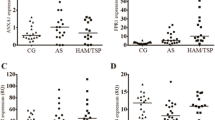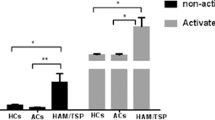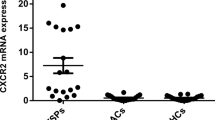Abstract
HTLV-1 infection causes a chronic progressive debilitating neuroinflammatory disease which is called, HTLV-1-associated myelopathy/tropical spastic paraparesis (HAM/TSP). One of the host defense mechanisms against viral infection is apoptosis which may control HTLV-1 infection. Therefore, we aimed to investigate this process and its interaction with viral factors in HTLV-1-infected asymptomatic carriers (ACs) compared to HAM/TSP patients. Fas, FasL, TRAIL, perforin, granzyme A, granzyme B, and granulysin gene expression and serum levels of Fas, FasL, TRAIL, and granulysin in the peripheral blood of 21 sex- and age-matched healthy controls (HCs), ACs, and HAM/TSP patients were evaluated. Also, the level of granulysin secretion in the cell culture supernatant was measured. Finally, the correlation of the expression of these molecules with HTLV-1 proviral load (PVL), Tax, and HBZ mRNA expression was analyzed. ACs compared to HAM/TSP patients significantly over-expressed the Fas, FasL, TRAIL, perforin, and granzyme B molecules. Fas, FasL, TRAIL, and granulysin serum levels were not different among studied groups; whereas, the secretion of granulysin was significantly decreased in ACs and HAM/TSP patients compared to HCs. Also, HAM/TSP patients expressed higher levels of HTLV-1 PVL, Tax, and HBZ mRNA. In addition, in ACs, inverse correlations between the Fas, FasL, TRAIL, perforin, granzyme B, and granulysin levels with HBZ mRNA expression were seen. ACs compared to HAM/TSP patients over-expressed the apoptosis- and cytotoxicity-related molecules. It could be concluded that successful control of the HTLV-1 infection and suppression of HAM/TSP development stem from the strong apoptosis and cytotoxic activity in the peripheral blood of ACs.



Similar content being viewed by others
References
Coffin JM (2015) The discovery of HTLV-1, the first pathogenic human retrovirus. Proc Natl Acad Sci USA 112(51):15525–15529
Gessain A, Cassar O (2012) Epidemiological aspects and world distribution of HTLV-1 infection. Front Microbiol 3:388
Rafatpanah H et al (2011) High prevalence of HTLV-I infection in Mashhad, Northeast Iran: a population-based seroepidemiology survey. J Clin Virol 52(3):172–176
Goncalves DU et al (2010) Epidemiology, treatment, and prevention of human T-cell leukemia virus type 1-associated diseases. Clin Microbiol Rev 23(3):577–589
Matsuura E, Yamano Y, Jacobson S (2010) Neuroimmunity of HTLV-I infection. J Neuroimmune Pharmacol 5(3):310–325
Nagai M et al (1998) Analysis of HTLV-I proviral load in 202 HAM/TSP patients and 243 asymptomatic HTLV-I carriers: high proviral load strongly predisposes to HAM/TSP. J Neurovirol 4(6):586–593
Yamano Y et al (2002) Correlation of human T-cell lymphotropic virus type 1 (HTLV-1) mRNA with proviral DNA load, virus-specific CD8(+) T cells, and disease severity in HTLV-1-associated myelopathy (HAM/TSP). Blood 99(1):88–94
Karimi M et al (2017) Role of the HTLV-1 viral factors in the induction of apoptosis. Biomed Pharmacother 85:334–347
Kattan T et al (2009) The avidity and lytic efficiency of the CTL response to HTLV-1. J Immunol 182(9):5723–5729
Sugata K et al (2015) Protective effect of cytotoxic T lymphocytes targeting HTLV-1 bZIP factor. Blood 126(9):1095–1105
Vine AM et al (2004) The role of CTLs in persistent viral infection: cytolytic gene expression in CD8+ lymphocytes distinguishes between individuals with a high or low proviral load of human T cell lymphotropic virus type 1. J Immunol 173(8):5121–5129
Mohammadi A et al (2017) Modulatory effects of curcumin on apoptosis and cytotoxicity-related molecules in HTLV-1-associated myelopathy/tropical spastic paraparesis (HAM/TSP) patients. Biomed Pharmacother 85:457–462
Mozhgani SH et al (2018) Interferon lambda family along with HTLV-1 proviral load, tax, and HBZ implicated in the pathogenesis of myelopathy/tropical spastic paraparesis. Neurodegener Dis 18(2–3):150–155
Yaghouti N et al (2019) Role of receptors for advanced glycation end products and high-mobility group box 1 in the outcome of human T cell lymphotropic type 1 infection. Viral Immunol 32(2):89–94
Barry M, Bleackley RC (2002) Cytotoxic T lymphocytes: all roads lead to death. Nat Rev Immunol 2(6):401–409
Waggoner SN et al (2016) Roles of natural killer cells in antiviral immunity. Curr Opin Virol 16:15–23
Benedict CA, Norris PS, Ware CF (2002) To kill or be killed: viral evasion of apoptosis. Nat Immunol 3(11):1013–1018
Abrams A, Akahata Y, Jacobson S (2011) The Prevalence and Significance of HTLV-I/II Seroindeterminate Western Blot Patterns. Viruses 3(8):1320
Thorstensson R, Albert J, Andersson S (2002) Strategies for diagnosis of HTLV-I and -II. Transfusion 42(6):780–791
Ogawa K et al (2003) Granulysin in human serum as a marker of cell-mediated immunity. Eur J Immunol 33(7):1925–1933
Rafatpanah H et al (2012) The impact of interferon-alpha treatment on clinical and immunovirological aspects of HTLV-1-associated myelopathy in northeast of Iran. J Neuroimmunol 250(1–2):87–93
Weinlich R, Brunner T, Amarante-Mendes GP (2010) Control of death receptor ligand activity by posttranslational modifications. Cell Mol Life Sci 67(10):1631–1642
Enose-Akahata Y, Vellucci A, Jacobson S (2017) Role of HTLV-1 tax and HBZ in the pathogenesis of HAM/TSP. Front Microbiol 8:2563
Saito M et al (2009) In vivo expression of the HBZ gene of HTLV-1 correlates with proviral load, inflammatory markers and disease severity in HTLV-1 associated myelopathy/tropical spastic paraparesis (HAM/TSP). Retrovirology 6:19
Tisato V et al (2016) Clinical perspectives of TRAIL: insights into central nervous system disorders. Cell Mol Life Sci 73(10):2017–2027
Hoffmann O, Zipp F, Weber JR (2009) Tumour necrosis factor-related apoptosis-inducing ligand (TRAIL) in central nervous system inflammation. J Mol Med (Berl) 87(8):753–763
Mc Guire C, Beyaert R, van Loo G (2011) Death receptor signalling in central nervous system inflammation and demyelination. Trends Neurosci 34(12):619–628
Lettau M et al (2011) Insights into the molecular regulation of FasL (CD178) biology. Eur J Cell Biol 90(6–7):456–466
Sessler T et al (2013) Structural determinants of DISC function: new insights into death receptor-mediated apoptosis signalling. Pharmacol Ther 140(2):186–199
Cummins N, Badley A (2009) The TRAIL to viral pathogenesis: the good, the bad and the ugly. Curr Mol Med 9(4):495–505
Brincks EL et al (2008) CD8 T cells utilize TRAIL to control influenza virus infection. J Immunol 181(7):4918–4925
Inoue A et al (1997) Detection of the soluble form of the Fas molecule in patients with multiple sclerosis and human T-lymphotropic virus type I-associated myelopathy. J Neuroimmunol 75(1–2):141–146
Sakai T et al (1999) Serum levels of apoptosis-related molecules in patients with multiple sclerosis and human T-lymphotropic virus Type I-associated myelopathy. J Interferon Cytokine Res 19(9):999–1004
Saito M et al (1999) Increased levels of soluble Fas ligand in CSF of rapidly progressive HTLV-1-associated myelopathy/tropical spastic paraparesis patients. J Neuroimmunol 98(2):221–226
Sakamoto N et al (2004) Soluble form of Fas and Fas ligand in serum and bronchoalveolar lavage fluid of individuals infected with human T-lymphotropic virus type 1. Respir Med 98(3):213–219
Kawahigashi N et al (1998) Predominant expression of Fas ligand mRNA in CD8 + T lymphocytes in patients with HTLV-1 associated myelopathy. J Neuroimmunol 90(2):199–206
Umehara F et al (2002) Involvement of Fas/Fas ligand system in the spinal cords of HTLV-I-associated myelopathy. Acta Neuropathol 103(4):384–390
Acknowledgements
We thank the healthy controls and HTLV-1-infected individuals for their cooperation. This study was financially supported by Grants no: 910236 and 921985 from Mashhad University of Medical Sciences (MUMS).
Author information
Authors and Affiliations
Corresponding authors
Ethics declarations
Conflict of interest
All authors declare that they have no conflict of interest.
Additional information
Edited by: Roberto F. Speck.
Publisher's Note
Springer Nature remains neutral with regard to jurisdictional claims in published maps and institutional affiliations.
Rights and permissions
About this article
Cite this article
Mohammadi, A., Fazeli, B., Poursina, Z. et al. HTLV-1-infected asymptomatic carriers compared to HAM/TSP patients over-express the apoptosis- and cytotoxicity-related molecules. Med Microbiol Immunol 208, 835–844 (2019). https://doi.org/10.1007/s00430-019-00625-6
Received:
Accepted:
Published:
Issue Date:
DOI: https://doi.org/10.1007/s00430-019-00625-6




